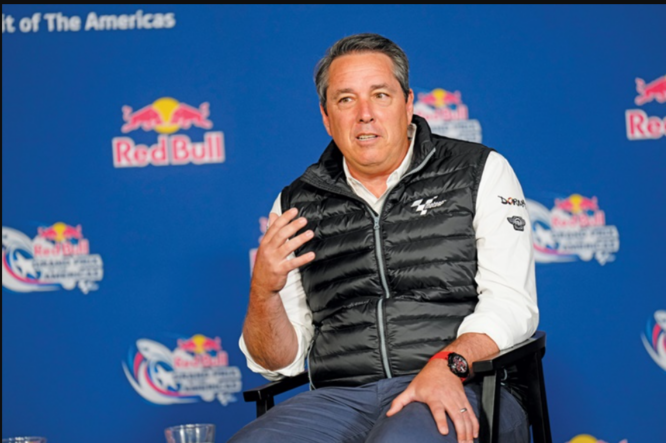Dan Rossomondo, MotoGP’s new American chief commercial officer, has been traveling the world and brokering deals for two months.
After 13 years in the NBA, Rossomondo joined Madrid-based Dorna Sports, which controls MotoGP and other motorcycle rights, in April. He was NBA worldwide partnerships and media senior VP.
MotoGP has 20 races on five continents from March to November in 2023, like Formula One. MotoGP hasn’t enjoyed the same popularity surge as F1 since 2020, which frustrated some in its sector and led to Rossomondo’s hire.
Dorna is Spanish-owned, and many riders are from Italy and Spain, hence the series’ strengths are Western Europe and Asia, where motorcycle use on city streets is much higher than in North America.
Thus, Rossomondo will be tasked with reaching out to the corporate community and motorsports fans in less popular markets like the U.S. F1 did the same when Liberty Media bought the European-centric, London-based property in 2016, hiring former ESPN executive Sean Bratches as chief commercial officer.

Bratches created the Netflix “Drive To Survive” series, which changed F1.
Rossomondo quipped that he hates socks like Bratches but added, “The other thing is, Sean worked his ass off. We’ll work hard too.”
Rossomondo visited his family in New Jersey during Memorial Day weekend and met with MotoGP media rights holder NBC Sports. He also met with sponsors. MotoGP sponsors include Tissot, Michelin, DHL, and Estrella Galicia.
MotoGP’s only U.S. race is held at Circuit of the Americas in Austin, but Rossomondo said he’s in contact with businesses interested in creating racing venues in America to attract more fans.
“One of the really fruitful conversations I’ve had [with MotoGP ownership] when I was joining Dorna and MotoGP is they said, ‘We need you to help us come up with a strategy for the U.S. and execute it,’” Rossomondo said. “There’s just a rabid fan base that will absolutely love this sport if they get to see it.”

Other Rossomondo quotes from Sports Business Journal are below.
U.S. market: “We’re very happy in Austin. I can’t wait for next year’s race. We can’t ignore the U.S. market until next year, so we’re already planning our next race there. Digital media and event-based operations are helping us achieve that.
However, unlike our F1 counterparts, we can only race on courses designed for rider safety, with large runoff sections where riders may slide after accidents to release energy before stopping. We need MotoGP circuit builders.
We’re discussing it. It’s not something we can solve quickly, but there are a few interested parties—some further along than others—and we’re going to pursue it vigorously because the greatest way to advertise the sport is exposing it to more people.”
“The tech transfer is off the charts. It’s not just helpful for their companies; we’re also trying to be good citizens of the world and MotoGP is attempting to demonstrate that what we do on 21 Saturdays and Sundays around the year helps these manufacturers to make leaps with two-wheel motorcycles for the future.”
On expanding the sport: “I give my team a lot of comforts when I say this: A lot of our issues are the same challenges other sports face.
What’s the digital transformation happening in the media landscape, staying on top of that, how are we balancing that need to market and promote our sport and generate revenue to support our entire enterprise, how do we make ourselves attractive to corporate partners because bringing in world-class brands will foster better marketing on our behalf. How can we improve market and fan listening?
We are a luxury sport with an accessible product and a dedicated, young, vibrant fan following. The key is that our Sunday race is 45 minutes and our Saturday sprint is 24 minutes. We have the right package for the next generation of sports fans, and we just need to tell that narrative and advertise it aggressively.”

